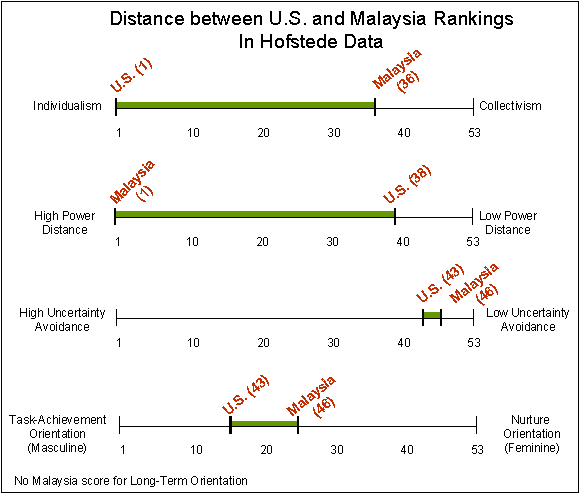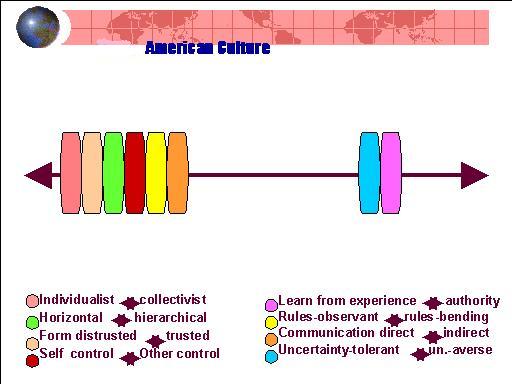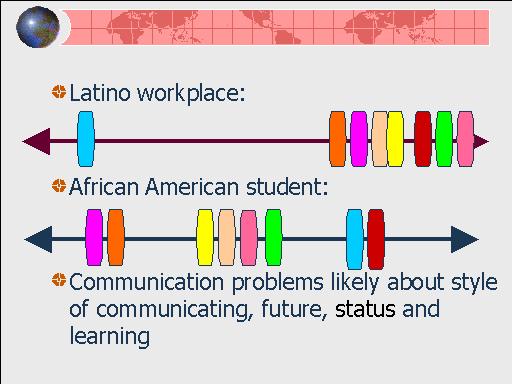
|
|
|
How
to use |
|
. |
|
|
.
|
What is Multimedia? the
delivery of a message written text, still images, animation, voice (sound), music, video. (Antti Peltonen, University of Oulu, Finland, 2002) |
.
Multimedia:
NOT JUST voice + written text
_.For example:
not ordinary teaching (voice + blackboard)
not this presentation so far (voice + text)
.
Multimedia (Minimal):
voice + written text + picture
-
teaching using drawings or photos
- this presentation now:
clockwork
=

clockwork
=

By adding ANIMATION, we can see how the two tabs move in and out.
So
multimedia makes concepts clearer. Often it is used just for this in
language learning: for example, explaining points of articulation in
phonetics. But language is not just concepts; it is a matrix of
intentionality. Multimedia has therefore a far more vital role in
language learning: creating a linguistic/cultural humus to
investigate

Click
here
for the sound
|
*Mike Leigh, Secrets and Lies, Channel Four Films, London, 1996 |
Compare:
|
(Phone rings twice) Mum:
Hello. |
Here, each Yes communicates the same thing: the concept of assent. But in the film clip, each Yes communicates a specific existential stance. True, in a novel or scenario each Yes could be described. But this does not help students cope with real life interaction in English. For in real life, descriptions are not provided and stances must be grasped holistically using multiple sensorial channels and the dynamics of personal involvement.
Multimedia
is therefore about integration
CONTENT - "Curricular integration means that language classes should be part of the culture and literature classes rather than a separate entity for the simple reason that one cannot separate a language from its cultural environment." -- Dlaska (2000) Integrating Culture and Language Learning in Institution-wide Language Programmes. ITE: Language, Culture and Curriculum, (13:3), 247-263. Bringing the living L2 into culture and literature classes, multimedia makes stances an object of study.
MATERIALS - "One of the key points introduced by the cognitive approach is the curricular integration ... in terms of its content, but also the integration of the various teaching / learning tools, especially the use of Computer Assisted Language Learning (CALL) and the Internet." -- Jacobs, G. M. & Farrell, T (2001). Paradigm Shift: Understanding and Implementing Change in Second Language Education. TESL-EJ, Vol.5 No1. Multimedia provides the focus (the linguistic/cultural humus) for integrating the Internet, e-books, CALL, etc., as 'extensions into the real world'.
This double integration means using multimedia to:
create
a linguistic/cultural humus for students to investigate
(constructivism). The humus is obtained
through viewing (anthropologically) and then re-enacting
(internalizing cultural values) documentary/feature film clips of
interaction in English. In the classroom, DVDs permit much easier AV
manipulation than with tape recorded media. Wideband Internet access
for distributed learning enables students to study the film clips
outside the classroom;
.
provide
multimodal (alongside single mode) extensions into the real world
for the empirical verification of hypotheses. Internet
chat rooms enable students to verify experimentally the meaning of
words. Audio streaming enables them to hear, live from radio
stations worldwide, the variety of English studied in the film
clips. Web searches enable them to document descriptively the
varieties encountered using linguistics sites (e.g., Summer
Institute of Linguistics). News groups can become focus groups to
solve problems in intercultural understanding.
.
furnish the holistic background for discrete element learning, with e-books, concordancers, CALL (integrative simulations, not just drills*)...
*See
the typology of CALL systems proposed by Austin & Fanning:
click>![]()
So
that learning can focus on a multimedia humus to explore,
we
need not only a new view of learning (constructivism)
but also a
new view of communication and language.
|
communication |
|
language |
How
to represent a cultural matrix?
G.
Hofstede, Culture's Consequences: International Differences in
Work-Related Values,1980.
Distribution
of middle American cultural/communicative traits
(L.
Beamer, http://www.dialogin.com, 2001)
Comparison
of cultural styles to identify points of friction.
(L.
Beamer, http://www.dialogin.com, 2001)
Trends:
Pragmatics
& Beyond
click
here>
![]()
Language
and Intercultural Communication
click
here>
![]()
The
integral mode of learning that multimedia offers
enables us
therefore to redefine our discipline (L-Lin/12):
the
study of English is the study of the sedimentation
of
instances of wills to mean in a particular way
that
produce classes of ways of being.
Discursively,
the ways of being manifest themselves through particular
cultural artefacts -- body language, emblems
and symbols, verbal language, interactional style, themes and
scripts... -- and practices, the forms of which
are historically motivated (alogical) tokens
of historically determined (sedimented) wills to mean.
Simulated+real interaction (multimedia+extensions) enables
learners to map experimentally the will behind a token,
otherwise accessible only through endless philological
reconstruction.
<<<>>>